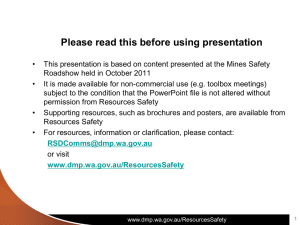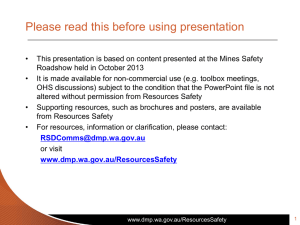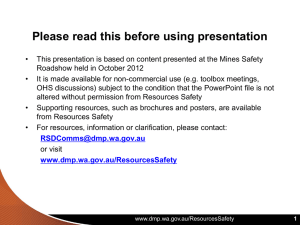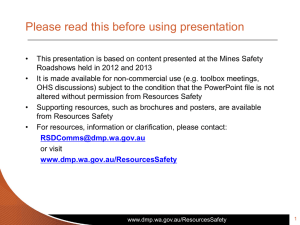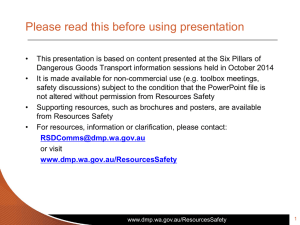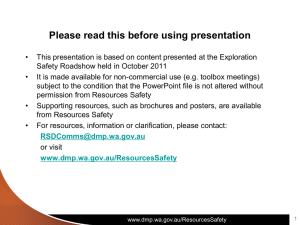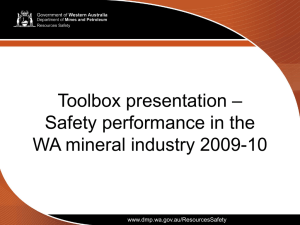what is the state-of
advertisement
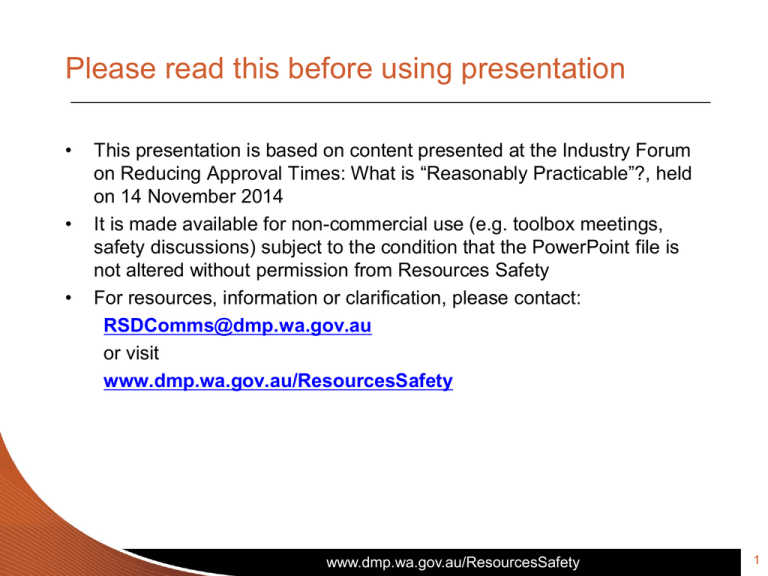
Please read this before using presentation • • • This presentation is based on content presented at the Industry Forum on Reducing Approval Times: What is “Reasonably Practicable”?, held on 14 November 2014 It is made available for non-commercial use (e.g. toolbox meetings, safety discussions) subject to the condition that the PowerPoint file is not altered without permission from Resources Safety For resources, information or clarification, please contact: RSDComms@dmp.wa.gov.au or visit www.dmp.wa.gov.au/ResourcesSafety www.dmp.wa.gov.au/ResourcesSafety 1 Petroleum safety and major hazard facilities What is the state-of-play in Western Australia? www.dmp.wa.gov.au/ResourcesSafety 2 DMP’s commitment To work with industry to reduce accidents and incidents, and provide tangible support in achieving a change in safety culture in order to minimise any impacts. www.dmp.wa.gov.au/ResourcesSafety 3 Resources Safety’s focus on petroleum and dangerous goods safety www.dmp.wa.gov.au/ResourcesSafety 4 A brief chronology of the recent past “Those that do not learn from history are condemned to repeat it” Winston Churchill 1 June 1974 • Flixborough, UK • 28 dead, 90 injured 10 July 1976 • Seveso, Italy • 3,000 pets, 70,000 livestock, ongoing population monitoring 3 December 1984 22 March 1987 6 July 1988 23 March 2005 11 December 2005 • Bhopal, India • 4,000 dead, 12,000 injured • Grangemouth, UK • 2 dead, 10 injured • Piper Alpha, Offshore UK • 167 dead, 60 injured • Texas City, USA • 15 dead, 100 injured • Buncefield, UK • 0 fatalities, 40 injured www.dmp.wa.gov.au/ResourcesSafety Case study: BP Grangemouth, Scotland BP Grangemouth had three incidents in 2000 that were front page news in the UK It took years for site to recover from adverse publicity and probably helped BP decide to exit petrochemicals SAFE EXPLORATION www.dmp.wa.gov.au/ResourcesSafety UK Health & Safety Executive (HSE) findings • Major accident hazard sites (MAHs) should be actively managed to allow control and the reduction of risks. Control of MAHs require a specific focus on process safety management over and above conventional safety management • KPIs should be developed for SAFE MAHs and EXPLORATION ensure process safety performance is monitored against these parameters • Disruption to utility supply systems (e.g. steam, electricity, cooling water) on a major hazard site can cause significant problems and have the potential to result in a major accident www.dmp.wa.gov.au/ResourcesSafety More HSE findings • Major hazard industries should ensure that knowledge available from previous incidents, both within their organisation and externally, is incorporated into current safety management systems • Operators should increase focus on preventing major accidents to ensure: – serious business risk is controlled – corporate governance is effective • COMAH regime is a “living process” and should be used as management tool to assist in process safety management COMAH = Control of major accident hazards www.dmp.wa.gov.au/ResourcesSafety MHFs – regulation, self management or both? The following are applicable to any facility — not just MHFs • The safety case and a safety management system (SMS) underpin the safe operation of MHFs • SMS provides structure and ensures facilities identify and more effectively manage their critical risks • It is not only about management but also leadership • Technical aspects of process safety management should be an embedded process including hazop, retro-hazop and ALARP principles www.dmp.wa.gov.au/ResourcesSafety • Industry messaging “what gets measured gets managed” or “what interests my boss fascinates me” are examples of ways of focussing attention on this. • As is emergency preparedness — prepare for incidents, they do happen! • Facilities can either use their SMS as a defence or embrace it as a way of demonstrating management commitment to safety and ensuring continuous improvement as part of life cycle of the plant • If industry can’t or won’t act, regulation is an outcome – the community (and therefore government) expects hazards to be identified and risks to be managed www.dmp.wa.gov.au/ResourcesSafety Piper Alpha commentary “The oil industry has yet to learn lessons of Piper Alpha” July 2013, Charles Woolfson, Linkoping University (on the 25th anniversary of incident) “Again, there is the same lethal cocktail of contingent circumstances and systemic underlying causes; multiple safety systems that did not function at the crucial moments, managerial failures immediately before and during the unfolding disaster, organisational failures embedded in distorted information flows and a lack of coherent safety management, defective regulatory authorities with contradicting responsibilities for both production and safety and even outright “capture” of regulatory processes by the industry itself.” Has anything changed? www.dmp.wa.gov.au/ResourcesSafety Societal obligations Final thoughts Society (the public) has an expectation that industry will protect its people, understand and manage its significant risks and also has an obligation to minimise its impacts on the wider community. An ongoing commitment to managing process safety is essential. Seveso Directorates (I, II, III) 1982/1996/2012 The Seveso directive obliges Member states to ensure operators have a policy in place to prevent major accidents. Operators handling dangerous substances above a certain threshold must regularly inform the public likely to be affected by an accident, providing safety reports, a safety management system and an internal emergency plan. (Prevention, Preparedness and Response) www.dmp.wa.gov.au/ResourcesSafety What might this mean for WA? • European Seveso directorate could be applied in Australia as: – part of a licence to operate – to meet community expectations • Any potential societal impacts of critical risks need to be factored into a site and boundary conditions as QRA is not a precise tool, although it recognises things can (and will) go wrong www.dmp.wa.gov.au/ResourcesSafety The way forward … As opportunities present themselves, corporate executives and management need to demonstrate leadership in educating both their workforce and the community to show their commitment to: • safe plant • safe people Are you prepared to do this or can you demonstrate that you are already? Any questions? www.dmp.wa.gov.au/ResourcesSafety Don’t forget – Stay informed! Visit www.dmp.wa.gov.au/ResourcesSafety to sign up for our weekly news alerts www.dmp.wa.gov.au/ResourcesSafety 15
